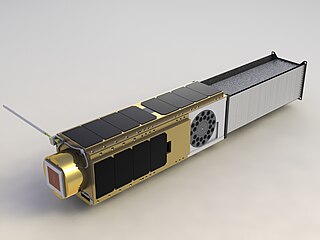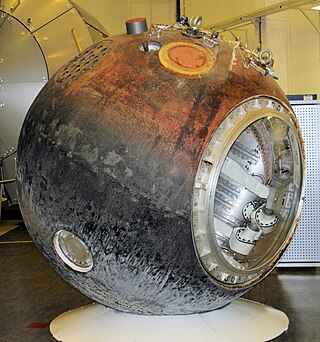The survival of some microorganisms exposed to outer space has been studied using both simulated facilities and low Earth orbit exposures. Bacteria were some of the first organisms investigated, when in 1960 a Russian satellite carried Escherichia coli , Staphylococcus , and Enterobacter aerogenes into orbit. [1] Many kinds of microorganisms have been selected for exposure experiments since, as listed in the table below.
Experiments of the adaption of microbes in space have yielded unpredictable results. While sometimes the microorganism may weaken, they can also increase in their disease-causing potency. [1]
It is possible to classify these microorganisms into two groups, the human-borne and the extremophiles. Studying the human-borne microorganisms is significant for human welfare and future crewed missions in space, whilst the extremophiles are vital for studying the physiological requirements of survival in space. [2] NASA has pointed out that normal adults have ten times as many microbial cells as human cells in their bodies. [3] They are also nearly everywhere in the environment and, although normally invisible, can form slimy biofilms. [3]
Extremophiles have adapted to live in some of the most extreme environments on Earth. This includes hypersaline lakes, arid regions, deep sea, acidic sites, cold and dry polar regions and permafrost. [4] The existence of extremophiles has led to the speculation that microorganisms could survive the harsh conditions of extraterrestrial environments and be used as model organisms to understand the fate of biological systems in these environments. The focus of many experiments has been to investigate the possible survival of organisms inside rocks (lithopanspermia), [2] or their survival on Mars for understanding the likelihood of past or present life on that planet. [2] Because of their ubiquity and resistance to spacecraft decontamination, bacterial spores are considered likely potential forward contaminants on robotic missions to Mars. Measuring the resistance of such organisms to space conditions can be applied to develop adequate decontamination procedures. [5]
Research and testing of microorganisms in outer space could eventually be applied for directed panspermia or terraforming.

Astrobiology is a scientific field within the life and environmental sciences that studies the origins, early evolution, distribution, and future of life in the universe by investigating its deterministic conditions and contingent events. As a discipline, astrobiology is founded on the premise that life may exist beyond Earth.

Panspermia is the hypothesis that life exists throughout the Universe, distributed by space dust, meteoroids, asteroids, comets, and planetoids, as well as by spacecraft carrying unintended contamination by microorganisms, known as directed panspermia. The theory argues that life did not originate on Earth, but instead evolved somewhere else and seeded life as we know it.

The possibility of life on Mars is a subject of interest in astrobiology due to the planet's proximity and similarities to Earth. To date, no proof of past or present life has been found on Mars. Cumulative evidence suggests that during the ancient Noachian time period, the surface environment of Mars had liquid water and may have been habitable for microorganisms, but habitable conditions do not necessarily indicate life.

Planetary protection is a guiding principle in the design of an interplanetary mission, aiming to prevent biological contamination of both the target celestial body and the Earth in the case of sample-return missions. Planetary protection reflects both the unknown nature of the space environment and the desire of the scientific community to preserve the pristine nature of celestial bodies until they can be studied in detail.

Astrobotany is an applied sub-discipline of botany that is the study of plants in space environments. It is a branch of astrobiology and botany.

EXPOSE is a multi-user facility mounted outside the International Space Station (ISS) dedicated to astrobiology. EXPOSE was developed by the European Space Agency (ESA) for long-term spaceflights and was designed to allow exposure of chemical and biological samples to outer space while recording data during exposure.

The Living Interplanetary Flight Experiment was an interplanetary mission developed by the Planetary Society. It consisted of sending selected microorganisms on a three-year interplanetary round-trip in a small capsule aboard the Russian Fobos-Grunt spacecraft in 2011, which was a failed sample-return mission to the Martian moon Phobos. The Fobos-Grunt mission failed to leave Earth orbit and was destroyed.

Deinococcus radiodurans is a bacterium, an extremophile and one of the most radiation-resistant organisms known. It can survive cold, dehydration, vacuum, and acid, and therefore is known as a polyextremophile. The Guinness Book Of World Records listed it as the world's toughest known bacterium.

The O/OREOS is a NASA automated CubeSat nanosatellite laboratory approximately the size of a loaf of bread that contains two separate astrobiology experiments on board. Developed by the Small Spacecraft Division at NASA Ames Research Center, the spacecraft was successfully launched as a secondary payload on STP-S26 led by the Space Test Program of the United States Air Force on a Minotaur IV launch vehicle from Kodiak Island, Alaska on 20 November 2010, at 01:25:00 UTC.
Interplanetary contamination refers to biological contamination of a planetary body by a space probe or spacecraft, either deliberate or unintentional.

Icebreaker Life is a Mars lander mission concept proposed to NASA's Discovery Program. The mission involves a stationary lander that would be a near copy of the successful 2008 Phoenix and InSight spacecraft, but would carry an astrobiology scientific payload, including a drill to sample ice-cemented ground in the northern plains to conduct a search for biosignatures of current or past life on Mars.

BIOPAN is a multi-user research program by the European Space Agency (ESA) designed to investigate the effect of the space environment on biological material. The experiments in BIOPAN are exposed to solar and cosmic radiation, the space vacuum and weightlessness, or a selection thereof. Optionally, the experiment temperature can be stabilized. BIOPAN hosts astrobiology, radiobiology and materials science experiments.

Exobiology Radiation Assembly (ERA) was an experiment that investigated the biological effects of space radiation. An astrobiology mission developed by the European Space Agency (ESA), it took place aboard the European Retrievable Carrier (EURECA), an unmanned 4.5 tonne satellite with a payload of 15 experiments.
ExoLance is a low-cost mission concept that could hitch a ride on other missions to Mars in an effort to look for evidence of subsurface life.
Exposing Microorganisms in the Stratosphere (E-MIST) is a NASA study to determine if a specific microorganism could survive conditions like those on the planet Mars. The study transported Bacillus pumilus bacteria and their spores by helium-filled balloon to the stratosphere of Earth and monitored the ability of the microorganisms to survive in extreme Martian-like conditions such as low pressure, dryness, cold, and ionizing radiation.
Cryomyces antarcticus is a fungus of uncertain placement in the class Dothideomycetes, division Ascomycota. Found in Antarctica, it was described as new to science in 2005. It has been found to be able to survive the harsh outer space environment and cosmic radiation. A proposed mechanistic contributor to the unique resilience observed in C. antarcticus is the presence of its thick and highly melanized cell walls. This melanin may act to protect DNA from damage while C. antarcticus is exposed to conditions that are unsuitable for typical DNA repair systems to function.
Daniela Billi is an Italian astrobiologist working at the University of Rome Tor Vergata. She is known for her work on desert cyanobacteria of the genus Chroococcidiopsis.
Astro microbiology, or exo microbiology, is the study of microorganisms in outer space. It stems from an interdisciplinary approach, which incorporates both microbiology and astrobiology. Astrobiology's efforts are aimed at understanding the origins of life and the search for life other than on Earth. Because microorganisms are the most widespread form of life on Earth, and are capable of colonising almost any environment, scientists usually focus on microbial life in the field of astrobiology. Moreover, small and simple cells usually evolve first on a planet rather than larger, multicellular organisms, and have an increased likelihood of being transported from one planet to another via the panspermia theory.
Mars habitability analogue environments on Earth are environments that share potentially relevant astrobiological conditions with Mars. These include sites that are analogues of potential subsurface habitats, and deep subsurface habitats.
Signs Of LIfe Detector (SOLID) is an analytical instrument under development to detect extraterrestrial life in the form of organic biosignatures obtained from a core drill during planetary exploration.
{{cite journal}}: CS1 maint: multiple names: authors list (link){{cite journal}}: CS1 maint: multiple names: authors list (link){{cite journal}}: CS1 maint: multiple names: authors list (link){{cite journal}}: CS1 maint: multiple names: authors list (link)